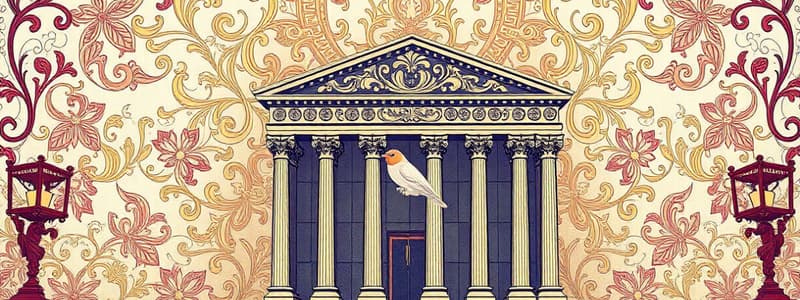Podcast
Questions and Answers
What is the primary responsibility of the judicial branch of the US government?
What is the primary responsibility of the judicial branch of the US government?
To interpret laws and ensure they are applied fairly.
Name the two types of lower federal courts in the US judicial system.
Name the two types of lower federal courts in the US judicial system.
District courts and circuit courts of appeal.
How many justices serve on the Supreme Court, and who leads the court?
How many justices serve on the Supreme Court, and who leads the court?
Nine justices, led by a Chief Justice.
What is the function of judicial review?
What is the function of judicial review?
From which landmark case does the power of judicial review arise?
From which landmark case does the power of judicial review arise?
What type of cases do federal courts have jurisdiction over?
What type of cases do federal courts have jurisdiction over?
What are the two main levels of federal courts below the Supreme Court?
What are the two main levels of federal courts below the Supreme Court?
How are Supreme Court justices appointed?
How are Supreme Court justices appointed?
Flashcards
Supreme Court
Supreme Court
The highest court in the U.S., responsible for interpreting the law and ensuring its fair application. Its decisions are final and have a major impact on society.
Judicial Review
Judicial Review
The power of the courts to examine and strike down laws or government actions that violate the Constitution.
Jurisdiction
Jurisdiction
A court's authority to hear and decide a case based on the subject matter or parties involved.
Appellate Review
Appellate Review
Signup and view all the flashcards
District Courts
District Courts
Signup and view all the flashcards
Circuit Courts of Appeal
Circuit Courts of Appeal
Signup and view all the flashcards
Judicial Branch
Judicial Branch
Signup and view all the flashcards
Federal Court System
Federal Court System
Signup and view all the flashcards
Study Notes
Introduction to the Judicial Branch
- The judicial branch of the US government is responsible for interpreting laws and ensuring they are applied fairly.
- It consists of the Supreme Court and lower federal courts.
- The courts' primary role is to adjudicate disputes according to established laws.
- Their actions are fundamental to maintaining the rule of law.
Structure of the Federal Courts
- The federal court system is hierarchical, with the Supreme Court at the apex.
- Lower federal courts include district courts (the trial courts) and circuit courts of appeal (courts of appeals).
- District courts handle most federal cases, often involving constitutional issues, federal crimes, or disputes over federal laws.
- Circuit courts review decisions made by district courts, ensuring they align with the law.
- Courts of Appeals are intermediate appellate courts, reviewing decisions from lower courts to ensure they are consistent with legal precedent and the Constitution.
The Supreme Court
- The Supreme Court is the highest court in the land, with the final say on legal interpretations.
- Composed of nine justices, led by a Chief Justice.
- The justices are appointed by the President and confirmed by the Senate.
- Their term lasts during "good behavior," typically lifetime appointments.
- The court hears cases that have reached the end of appellate review in lower courts.
- Often, cases involve significant legal or constitutional questions.
- Key function is judicial review, evaluating laws and government actions against the Constitution.
- Decisions often have far-reaching implications for policy and society.
Jurisdiction
- Federal courts have jurisdiction over cases involving federal law, treaties, or the US Constitution.
- Cases dealing with citizens of different states (diversity jurisdiction) or disputes affecting the federal government's rights are also considered.
- Limitations on jurisdiction exist; some cases are reserved for state courts.
Judicial Review
- Judicial review is the power of the court to examine and potentially invalidate laws passed by Congress or actions taken by the executive branch.
- Stemming from the landmark case Marbury v. Madison.
- This power is crucial as it prevents the other branches from acting outside of their constitutional bounds.
- Through judicial interpretation, the court shapes and applies the Constitution to contemporary issues.
Due Process and Equal Protection
- The Fourteenth Amendment guarantees due process and equal protection under the law.
- These principles are essential in cases addressing discrimination, or the rights of the accused.
- Courts interpret and apply these guarantees in diverse cases.
The Court's Role in American Society
- Judicial decisions can significantly affect American society.
- Court interpretations can reshape social practices, policies, and behaviors.
- Court rulings often trigger public debate and create lasting impacts on various aspects of society, including privacy, criminal justice, and civil rights.
Studying That Suits You
Use AI to generate personalized quizzes and flashcards to suit your learning preferences.
Description
Explore the structure and function of the judicial branch of the US government. This quiz covers the roles of the Supreme Court, district courts, and circuit courts, emphasizing their importance in interpreting and applying laws. Test your knowledge of how the federal court system maintains the rule of law.




